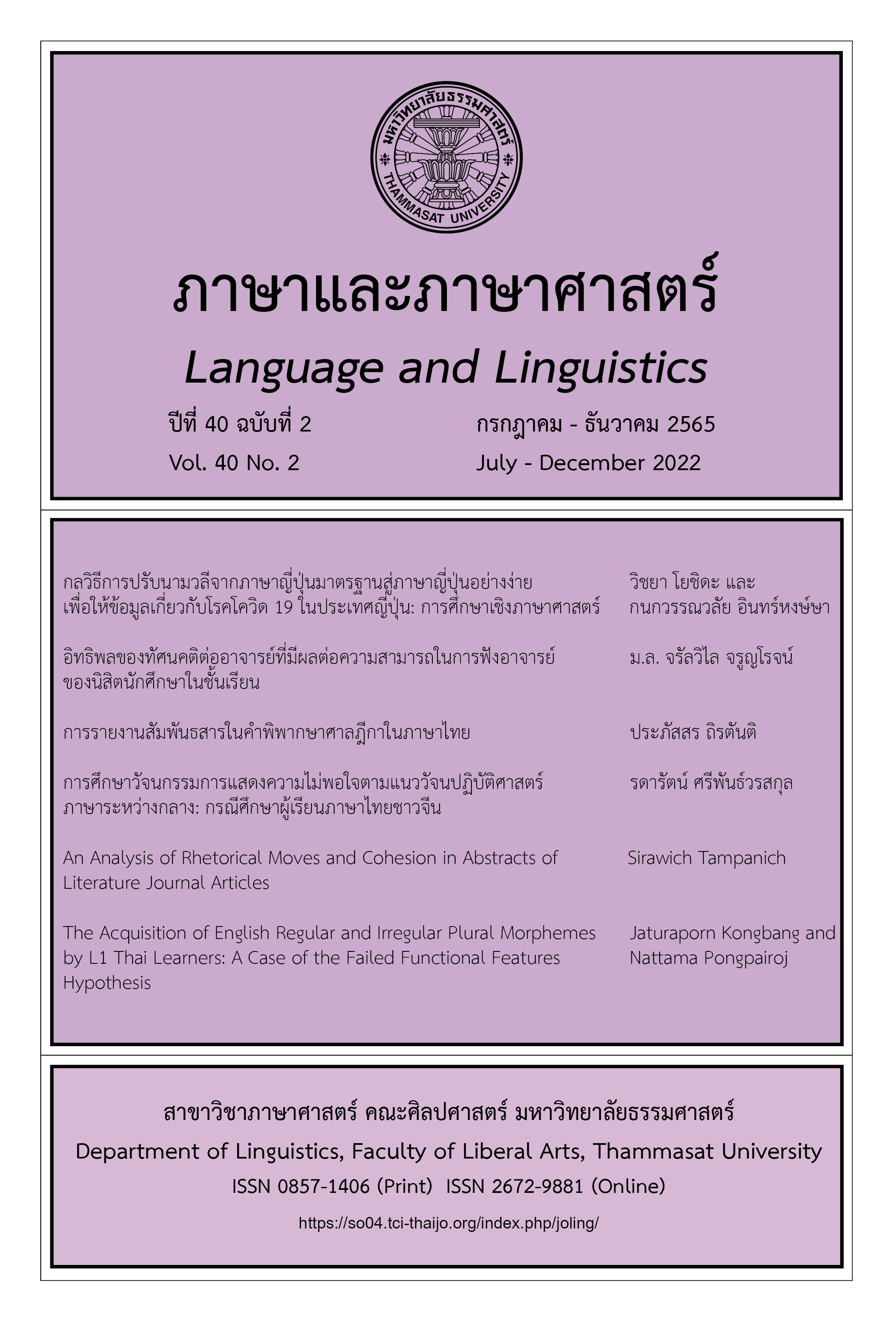An Analysis of Rhetorical Moves and Cohesion in Abstracts of Literature Journal Articles
Main Article Content
Abstract
An abstract is considered as the essential part of an article. However, the textual organization of the abstracts in diverse genres may differ, which is likely to cause confusion and concern among novice EFL scholars. Also, so far there have been few practical models available on how to write a well-composed literature research article (LRAs) abstract. Therefore, to fill in this missing piece, the present researcher conducted an analysis of abstracts in LRAs, with the main focus on rhetorical moves and generic patterns together with grammatical cohesion. With the top-down corpus-based approach of move analysis, the move structure model was modified from the models proposed by Doró (2013), Santos (1996), Swales and Feak (2009), and Tankó (2017). The corpus consisted of 88 abstracts from two international journals. The abstracts were analyzed and coded by considering the functional roles of each structural unit which variably fell into different ‘moves’ and ‘submoves’, and grammatical cohesion. Two research instruments were employed including: MS Excel 2013 and AntConc Version 3.5.8.0. The results indicated that, of eight moves, the Findings (M6) was the most frequent move, and LRA abstracts revealed five generic patterns with three stable moves functioning as Research Presentation (M4), Methodology (M5), and Findings (M6). Regarding grammatical cohesion, the reference type of cohesive devices was the most utilized in LRA abstracts. The findings could serve as a practical guideline for novice EFL scholars providing detailed information as to how LRA abstracts should be composed and organized to meet the standards for literary research publications.
Article Details

This work is licensed under a Creative Commons Attribution-NonCommercial-NoDerivatives 4.0 International License.
บทความทุกบทความเป็นลิขสิทธิ์ของภาษาและภาษาศาสตร์
References
American Psychological Association. (2020). Publication manual of the American Psychological Association (7th ed.). American Psychological Association
Biber, D., Connor, U., & Upton, T. A. (2007). Discourse on the move using corpus analysis to describe discourse structure. John Benjamins.
Crookes, G. (1986). Towards a validated analysis of scientific text structure. Applied Linguistics, 7, 57-70.
Cross, C., & Oppenheim, C. (2006). A genre analysis of scientific abstracts. Journal of Documentation, 62(4), 428-446.
Doró, K. (2013). The rhetoric structure of research article abstracts in English studies journals. Prague Journal of English Studies, 2, 119-139.
Dudley-Evans, T. (1986). Genre analysis: An investigation of the introduction and discussion sections of MSc. dissertations. In M. Coulthard (Ed.), Talking about text (pp. 128-145). English Language Research, The University of Birmingham.
Halliday, M. A. K., & Hasan, R. (1976). Cohesion in English. Longman.
Halliday, M. A. K., & Matthiessen, C. M. I. M. (2014). Halliday’s introduction to functional grammar (4th ed.). Routledge.
Hyland, K. (2000). Disciplinary discourses: Social interactions in academic writing. Longman.
Kanoksilapatham, B. (2005). Rhetorical structure of biochemistry research articles. English for Specific Purposes, 24(3), 269-292.
Kanoksilapatham, B. (2013). Generic characterisation of civil engineering research article abstracts. The Southeast Asian Journal of English Language Studies, 19(3), 1-10.
Lon, C. E., Tan, H., & Abdullah, A. N. (2012). Conveying communicative intent: Moves and metadiscourse in abstract writing. International Journal of Applied Linguistics and English Literature, 1(7), 56-65.
Lorés, R. (2004). On RA abstracts: From rhetorical structure to thematic organization. English for Specific Purposes, 23(3), 280-302.
Marefat, H., & Mohammadzadeh, S. (2013). Genre analysis of literature research article abstracts: A cross-linguistic, cross-cultural study. Applied Research on English Language, 2(2), 37-50.
Martín, P. M. (2003). A genre analysis of English and Spanish research paper abstracts in experimental social sciences. English for Specific Purposes, 22, 25-43.
Pasavoravate, Y. (2011). Genre analysis of thesis and dissertation abstracts in linguistics written by students in Thailand and students in England. [Unpublished doctoral thesis], Chulalongkorn University.
Pho, P. (2008). Research article abstracts in applied linguistics and educational technology: A study of linguistic realizations of rhetorical structure and authorial stance. Discourse Studies, 10(2), 231-250.
Samraj, B. (2005). An exploration of a genre set: Research article abstracts and introductions in two disciplines. English for Specific Purposes, 24(2), 141-156.
Santos, M. B. D. (1996). The textual organization of research paper abstracts in applied linguistics. Text, 16(4), 481-499.
Stotesbury, H. (2003). Evaluation in research article abstracts in the narrative and hard sciences. Journal of English for Academic Purposes, 2(4), 327-341.
Suntara, W., & Usaha, S. (2013). Research article abstracts in two related disciplines: Rhetorical variation between linguistics and applied linguistics. English Language Teaching, 6(2), 84-99.
Swales, J. M. (1990). Genre analysis: Explorations and applications. Cambridge University Press.
Swales, J. M. (2004). Research genres: Explorations and applications. Cambridge University Press.
Swales, J. M., & Feak, C. B. (2009). Abstracts and the writing of abstracts. The University of Michigan Press.
Swales, J. M., & Feak, C. B. (2012). Academic writing for graduate students. The University of Michigan Press.
Tankó, G. (2017). Literary research article abstracts: An analysis of rhetorical moves and their linguistic realizations. Journal of English for Academic Purposes, 27, 42-55.
Tampanich S., & Soranastaporn, S. (2018). Word frequency and sentence structure in stating objectives in review articles: Useful findings for EFL learners and novice researchers. KKU International Journal of Humanities and Social Sciences, 8(1), 91-125.
Tseng, F. (2011). Analyses of move structure and verb tense of research article abstracts in applied linguistics journals. International Journal of English Linguistics, 1(2), 27-39.


